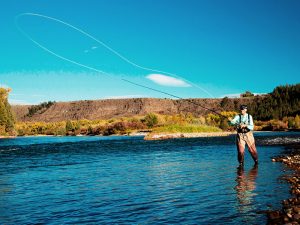Why You Should Develop Good Spey Casting Techniques
If you’re a fisherman and specifically an angler that uses fly fishing techniques then spey casting is a style you will certainly want in your ‘tackle box’ so to speak.
 The technique allows for extreme accuracy, which is a very important factor when you’re fly fishing. You can utilize a normal length fly rod or alternatively a rod called the double-handed fly rod or spey rod with distance and accuracy in mind. All though standard overhead casting can also be performed with spey rods.
The technique allows for extreme accuracy, which is a very important factor when you’re fly fishing. You can utilize a normal length fly rod or alternatively a rod called the double-handed fly rod or spey rod with distance and accuracy in mind. All though standard overhead casting can also be performed with spey rods.
The technique and rods are primarily used when going after larger fish in larger bodies of water like a wide mouth river for example. Big trout, both freshwater and sea trout are a common catch with this method and if you use spey casting for steelhead and large salmon this is also ideal. The technique will provide the angler with a more powerful long distance cast while avoiding obstacles on the shore from which you are casting keeping your fishing line directly in front of you.
Spey Fishing Tackle And Casting Styles
There are several styles and spey casting techniques for the angler to choose from depending on where you are fishing and what the conditions are. There is traditional spey casting where you use a fixed line from 80 to 100 feet long and you lock it down and maintain that distance. You pick up the locked in line and make a ‘D’ loop behind your back then cast out changing the direction and location of where you want your spey fishing tackle to land. This was the initial form of spey casting techniques developed centuries ago in Scotland.
Now in the modern era of fly rod fishing a more advanced technique is commonly used known as the Scandinavian method, that was originally developed in the 1960’s for fishing tournament entrants. With this technique the design of the rod is shorter in length with a faster taper. These rods were designed to focus a narrow tight loop and release a long tight cast.
The spey fishing tackle that allows this is a shooting head and monofilament line after the shooting head, Fisherman find this technique is not only a great way to cast far using a lighter weight rod and makes it a lot more fun catching the fish because of the simplicity. The disadvantage is that after every swing you must manually retrieve the line back up to the shooting head.
In the 1980’s came a new technique specific for spey casting for steelhead fishing. A new style of fly fishing rod was developed that made it easier to cast a sinking tip fly line combined with a heavily weighted fly. This technique become popular for steelhead fisherman on the Skagit River in northern Washington state and so it was named the technique Skagit style casting.
This is a method of casting developed for using the least powerful most flexible easy to load rods. The method of the cast employs a fixed anchor point also known as a sustained anchor point. Rather than the touch splash and go cast you can position the line, let it sit in the water for a moment and when you are ready swing the line back around and cast.
These rods have a much deeper bending action on purpose to open the loop so that the heavy sink tip and fly do not catch and or tangle during the casting stroke. Typically this rod uses a monofilament line after the shooting head but there are also lines available with an integration into the thin fly line. This will cut some distance from your cast but some anglers prefer not handling the monofilament and this is another option.
So these are the 3 dominant styles used in spey casting around the world. Standard, Scandinavian and Skagit style. Whether you are spey casting for steelhead or other fish varieties one of these 3 methods will certainly fill your needs and become your favorite techniques.
Professional and competitive fisherman will tell you it’s not just important to learn and know how to spey cast but even more importantly you must understand how the cast works to get the most out of these techniques.
When you get the fundamentals down and understand the cast from the basic physical motion up to a full understanding of the execution of the technique then you can begin to cast very tight every time with extreme accuracy. This by far will get you better results, more fish and teach you that it’s not about distance or long casting but more about a good clean accurate fly. In the end spey casting is all about accuracy and the ability for the angler to be as precise with their cast as possible.
